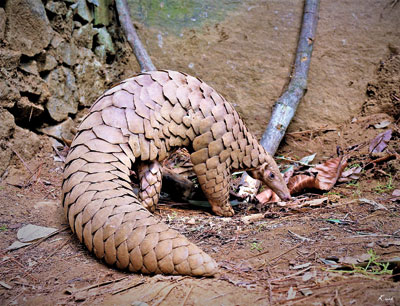News
Study will help protect anteater targeted by smugglers

Dr. Priyan Perera
A new study has taken the first step in Sri Lanka to shed light on an elusive, solitary mammal that is the world’s most trafficked mammal.
Last year, a live pangolin was rescued from a freezer in Chinese restaurant in Colombo, and the year before that, attempts to smuggle 130kg of pangolin scales that could have come from some 150 animals were found in Kalpitiya.
Pangolins are in high demand in East Asia and there are fears that, particularly with the large Chinese workforce in Sri Lanka, local pangolins are being increasingly targeted for flesh and scales rather than for low-level consumption as bushmeat by local communities.
The pangolin is one of the least studied mammals: there is very little data about their distribution, population or threats. Until now, our information mainly came from a 40-year-old report by W. Phillips.
To fill this void, an islandwide survey by researchers of the University of Sri Jayawardenepura resulted in a paper published last week that shows where these animals live and what threats they face.
Researcher Dr. Priyan Perera said the survey commenced in 2013 with a team conducting interviews with officers of Department of Wildlife Conservation villagers and even a few possible poachers.
The research team also reviewed records of rescued or dead pangolins stored in field offices of the wildlife department records of confiscations by the Department of Customs.

The pangolin is one of the least studied mammals
There are eight pangolin species in the world. The Indian pangolin (Manis crassicaudata), is the species found in Sri Lanka, where it is known as “kebellawa” or “eya” in Sinhala and “alangu” in Tamil.
Pangolins are known as “scaly anteaters” because of the keratinised plate-like protective scales covering much of their bodies, and their highly specialised diet, which predominantly consists of ants and termites.
They coil into a ball when threatened and their scaly body armour usually protects them from the teeth and claws of jungle predators – but not from humans.
Pangolin scales are used in traditional Chinese “medicines” and this demand has created an illegal wildlife trade around the world.
Because of this, of the four Asiatic species, two are “critically endangered” and the other two are “endangered” according to the International Union for Conservation of Nature.
“The over-exploitation of Chinese pangolin (Manis pentadactyla) and Sunda pangolin (Manis javanica) populations in Asia has led to an increase in the hunting of Indian pangolins in India and Pakistan,” Dr. Perera said. Smugglers now threaten Sri Lanka’s pangolin population, he warned. There have been reported cases of pangolin meat offered for sale in restaurants, especially for Asian workers employed in megadevelopment projects in the country.
“Sri Lanka needs to be vigilant and stop the illegal international trade in pangolin parts before it is too late,” Dr. Perera said.
The study shows the highest number of wildlife crimes related to pangolins was recorded from the Anuradhapura District (13.54 per cent), followed by Polonnaruwa (12.50 per cent), Hambantota (10.42 per cent), Moneragala (9.38 per cent) and Kalutara (8.33 per cent).
The main exploitation threats facing Indian pangolins are hunting for subsistence (47.4 per cent), hunting for bushmeat (27.8 per cent), incidental capture in traps intended for pests (11.3 per cent), hunting for scales (6.2 per cent) and trading of live animals for meat (6.2 per cent).
The study shows pangolins can be found in all parts of the country, up to an elevation of 1850m, mainly in the north-west (Kurunegala and Puttalam districts), the Anuradhapura district and the south-west lowlands and south-east (Hambantota and Monaragala districts).
Pangolins are nocturnal animals and they sleep during the day in burrows, hollows or dens. They are solitary mammals, seldom seen in groups.
They usually give birth to one offspring, on rare occasions, two. The female carries its newborn on its tail. They are caring mothers that coil their bodies around their babies if a threat arises.
Researchers stress this study has important implications in national and global conservation planning of the species.

